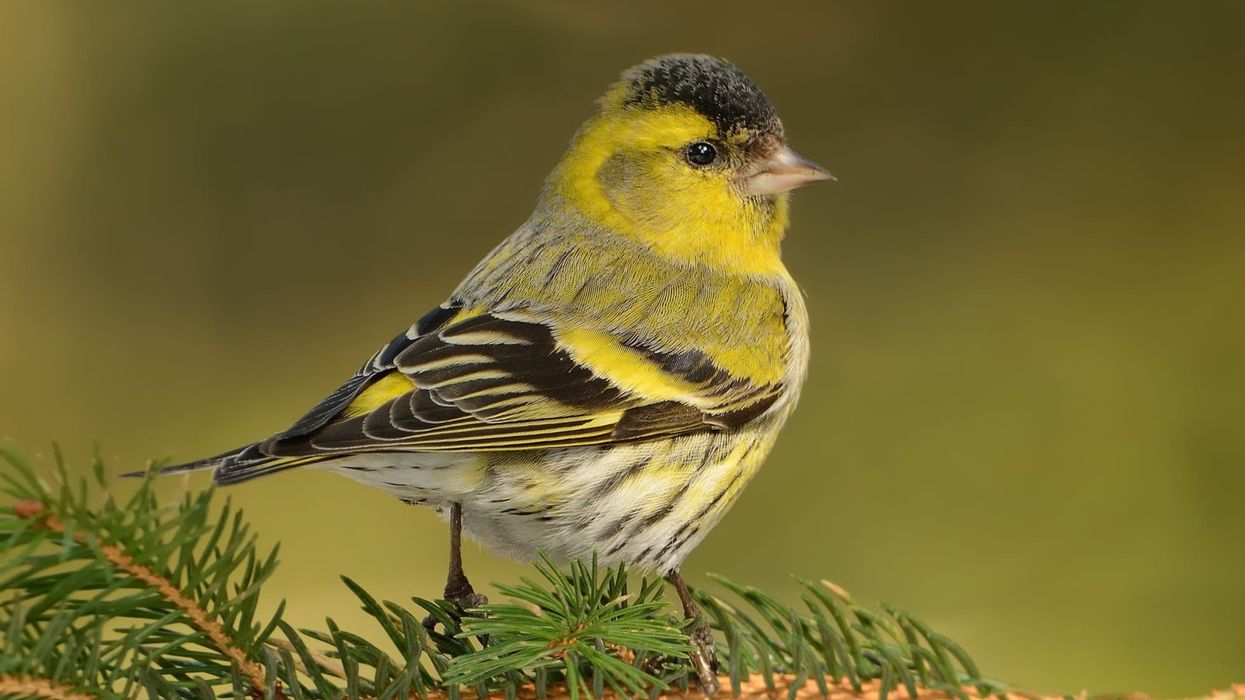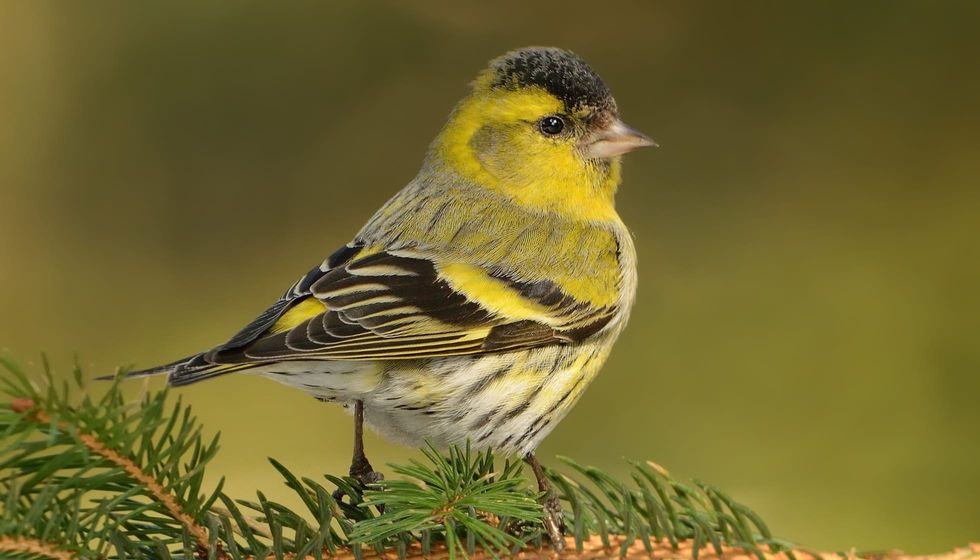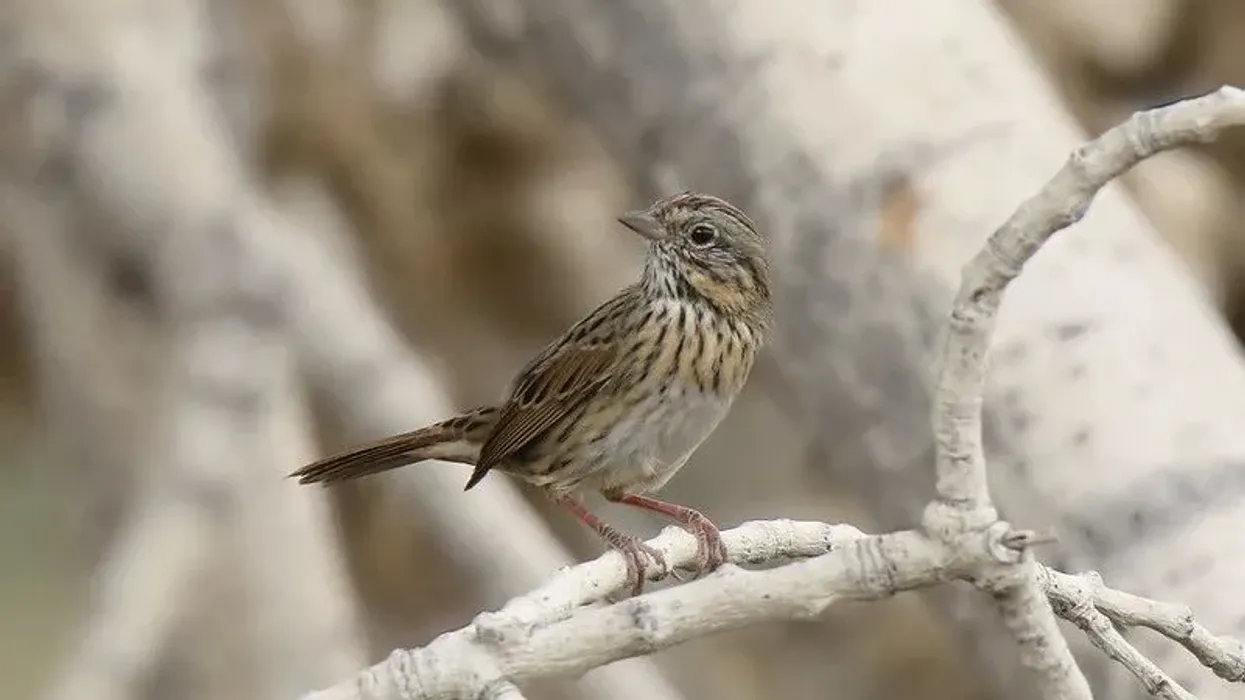Do you like small colorful birds, like the yellow warbler? Then here we have all the information on the Eurasian siskin.
The Eurasian siskin (Spinus spinus) is a migratory bird that resides in parts of Eurasia. The Eurasian siskin and pine siskin are two closely related birds that differ slightly in appearance.
Male Eurasian siskins have a black cap, while the female has a more grayish cap. They have a yellow chin patch and an overall greenish-yellow colored plumage with dark brown eyes. These birds look beautiful when they are in flight.
The breeding season of this species occurs around February to August, and the juvenile Eurasian siskin leaves the nest at around 13-15 days after the eggs hatch. These birds are mostly solitary, only seen in small groups or flocks during foraging.
They eat both animal and plant-based food. They are known to feed on all kinds of insects, spiders, worms, fruits, seeds of trees, like spruce, hemlock, and larch.
For more relatable content, check out these umbrellabird facts and ovenbird facts for kids.
Eurasian Siskin Interesting Facts
What type of animal is a Eurasian siskin?
The Eurasian siskin is a species of bird.
What class of animal does a Eurasian siskin belong to?
The Eurasian siskin belongs to the class Aves of animals.
How many Eurasian siskins are there in the world?
The population range of Eurasian siskins in Europe is about 27,200,000-42,100,000 mature birds. Europe is known to form around 55% of the global population range of these birds. This equates to about 49,000,000-77,000,000 mature birds on a global scale. The population trend has been seen to be decreasing owing to not enough food resources in some places.
Where does a Eurasian siskin live?
The Eurasian siskin range is scattered throughout Europe and Asia. They can be seen in the east from Poland and Baltic regions to western central Russia, from western Siberia and northern central Kazakhstan to the upper Ob River.
They have been seen from the Balkans and north and south Italy to north Greece, from north of Scandinavia to central and north Spain.
In the south, this bird occurs from northern and northwestern Turkey and the west Caucasus eastwards to northern Iran.
In the Russian far east, this bird can be spotted from the Yablonovy range and Lake Baikal eastwards to Sakhalin, coasts of Sea of Okhotsk, South Kuril islands, Ussuriland, Transbaikalia, and northeast China. At times, Eurasian siskins can be seen in parts of north Japan in Asia and central Kamchatka.
What is a Eurasian siskin's habitat?
The primary wild habitat of these breeding birds includes montane and submontane conifer forests and temperate and boreal lowlands. They also prefer gardens, parks, mixed conifer, non-native conifer along with conifer forests. Non-breeding birds live in the same wild habitat as well, in addition to lakeside or riverine alders, weedy thickets, heaths, and common orchards.
Who do Eurasian siskins live with?
Eurasian siskins are known to be solitary. Some birds can be seen living in loose groups or flocks made up of a maximum of 20 pairs or so. These groups are mainly seen during foraging.
How long does a Eurasian siskin live?
The Eurasian siskin lifespan is about two years.
How do they reproduce?
The breeding season of the Eurasian siskin bird species occurs around February to August. These birds are monogamous in nature.
Courtship behavior includes a male facing a female. The male then fluffs out his breast, droops his quivering wings, ruffles his black crown before he raises and spreads his tail and sings. Other manners of courtship behavior also occur.
Mostly the Eurasian siskin female builds the nest and the male helps with the nest building. After copulation, the female lays three to five eggs on average, and one to two broods are laid in a year. The female then incubates the eggs alone for the next 12-13 days.
Both parents care for the young ones for the next 13-15 days. The young ones leave the nest around that time.
What is their conservation status?
The conservation status of the Eurasian siskin, according to the International Union for Conservation of Nature, is listed as Least Concern. For preservation measures within their wild habitat range, these birds have been protected under the Bern Convention Appendix II.
Eurasian Siskin Fun Facts
What do Eurasian siskins look like?
The Eurasian siskin is a small-sized bird. Sexual dimorphism has been seen in the species. The adult male has overall yellowish-green feathers.
On the dorsal side, the rump has a more yellow shade and the scapulars have black streaks. The upper wings are black with yellow edges, and two yellow wing bars can also be seen. These birds have a forked tail, which is black in adult males.
The longer outer tail feathers have a yellow patch at the base. On the ventral side, the belly is whitish with gray streaks, and the breast and throat are yellow-colored.
The sides of the male are white with heavy black streaks. The chin, forehead, crown, and head are black. Nape, cheeks, and ear coverts are pale yellowish-gray.
Females are almost the same but duller. The dorsal side is pale yellow-colored with gray streaks, and the ventral side is the same as a male but with heavier gray streaks. In the places where black can be seen in the males, a rather brownish-gray plumage can be seen in females.
Legs and feet of both sexes are brownish-pink, and eyes are dark brown-colored.

How cute are they?
Owing to their beautiful colors and small size, this bird species can be considered pretty cute. These birds are also not aggressive in nature except towards birds of their own species during the breeding season. This certainly adds to their charm.
How do they communicate?
Eurasian siskins communicate visually and vocally. These birds sing and call in various situations.
How big is a Eurasian siskin?
An adult Eurasian siskin is about 4.3-4.7 (11-12 cm) in length, while their wingspan is about 7.9-9 in (20-23 cm). They are slightly smaller than house finches, which are about 5-6 in (12.5-15 cm) in length.
How fast can a Eurasian siskin fly?
The exact speed at which these birds fly is unknown.
How much does a Eurasian siskin weigh?
These are small-sized birds. An adult Eurasian siskin weighs about 0.3-0.6 oz (10.1-18.5 gm).
What are the male and female names of the species?
Males of the species are called cocks, and females of the species are called hens.
What would you call a baby Eurasian siskin?
A baby Eurasian siskin is called a hatchling or a chick.
What do they eat?
The diet of these birds is omnivorous. In terms of animal-based food, this bird feeds on mollusks, earthworms, spiders, the adult and larvae of insects, like small beetles, bugs, moths, damselflies, and mayflies.
In terms of plant-based food, this bird feeds on fruits, peanuts, buds, seeds from many trees, like sow-thistle, mugwort, willowherb, wintergreen, goosefoot, maple, hemlock, larch, spruce, and pine.
Are they friendly?
They are not aggressive towards humans. These birds have rather been seen to frequent garden feeders. Some people also keep them as pets and the birds respond well to captivity.
Would they make a good pet?
Not many people keep them as pets, but Eurasian siskins are known to adapt well to life in captivity. Their non-aggressive nature and the fact that they are easy to care for attracts many people.
Did you know...
The exact meaning of the word 'siskin' is not known. However, it comes from the German word 'zeischen' or 'sisschen', the origin of which goes back to Slavic languages.
These birds have a unique way of catching their prey. When they forage from a tree, they choose a slender tree branch or seedheads of docks and thistles and catch their prey by hanging upside down from that tree branch, like a long-tailed tit bird.
What is the Eurasian siskin's call?
Eurasian siskins have various calls according to different situations. Their alarm call sounds like a rising sharp 'tsooeet'. The flight calls sound like a dry 'tet-tet' or 'tet', and a ringing high-pitched 'tsuueee' or 'toolee'. Territory call sounds like 'twillit', a more chattering 'titteree', or a trilling 'tirrillili'. Foraging groups calls are more like chipping twitters or soft chirps.
What is the Eurasian siskin's migration pattern?
Eurasian siskins are migratory birds that move far for winter. Resident Eurasian siskins of the southern parts migrate short distances for the winter.
Resident birds of this species living in the northern parts migrate longer distances in winter to the south and southwestern parts, mainly from the Mediterranean islands and south Spain eastwards to south Kazakhstan, Israel, Turkey, central north Iran, and Lebanon.
Birds of the eastern part of Asia migrate south in winter to Japan, Korea, southeastern and eastern China, and north Mongolia.
Here at Kidadl, we have carefully created lots of interesting family-friendly animal facts for everyone to discover! Learn more about some other birds from our red bird of paradise facts and cardinal bird facts pages.
You can even occupy yourself at home by coloring in one of our free printable paradise riflebird coloring pages.









